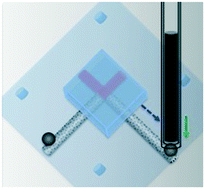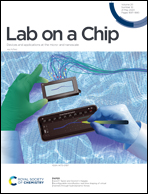Bioinspired reconfiguration of 3D printed microfluidic hydrogels via automated manipulation of magnetic inks†
Abstract
One of the key components in controlling fluid streams in microfluidic devices is the valve and gating modules. In most situations, these components are fixed at specific locations, and a new reconfiguration of microchannels requires costly and laborious fabrication of new devices. In this study, inspired by the human vasculature microcapillary reconfiguration in response to blood transport requirements, the idea of reconfigurable gel microfluidic systems is presented for the first time. A simple approach is described to print microchannels in methacrylated gelatin (GelMA) hydrogels by using agarose fibers that are loaded with iron microparticles. The agarose fibers can then be used as valves, which are then manipulated using a permanent magnet, providing the reconfigurability of the system. The feasibility of agarose gels is tested with different iron microparticle loadings as well as their resistance to fluid flows. Further, it is shown that using this technique, multiple configurations, as well as reconfigurability, are possible from a single device. This work opens the framework to design more intricate and reconfigurable microfluidic devices, which will decrease the cost and size of the final product.



 Please wait while we load your content...
Please wait while we load your content...